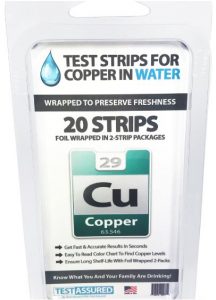
Copper in Your Drinking Water
Copper is abundant in the environment and occasionally makes its way into drinking water supplies. It can leach into water sources through rocks, soil, and copper piping. Because excessive copper has been found to cause several unpleasant side effects in human beings, the Environmental Protection Agency developed guidelines on the amount of copper that can be present in drinking water.
Government officials test public water supplies regularly to ensure copper contaminants are at or below acceptable levels. However, if your drinking water comes from a private source such as a well, your water is not being tested.
How Does Copper Get in Water?
Copper is a metal that exists naturally in water, soil, plants, and animals. Copper can end up in water supplies as a result of several different industrial processes, including mining, farming, and factory work. Copper pipes can corrode, releasing more copper into the water.
How to Test for Copper in Water
If you get your water from a private well, it is your responsibility to regularly test your water and monitor contamination levels. Your state certification officer can recommend laboratories that perform water analysis, including tests for copper. Professional testing can be expensive, and it can take a while for you to receive results. If the lab is not nearby, you may have to collect the samples yourself and mail them to the lab.
Another option to test your water for copper is a home testing kit. TestAssured sells a kit specifically to test for copper.
 To perform the copper test:
To perform the copper test:
- Remove the test strip from the packet.
- Pick up the strip at the end with no pads.
- Dip the strip in the sample three times and remove without shanking off excess water.
- Hold the test strip level for 2 seconds.
- Place the strip on the results color chart to determine the copper level of your water.
What Are Normal Copper Levels in Drinking Water?
Scientific testing has found that humans experience vomiting, jaundice, diarrhea, nausea, and stomach pain when they ingest copper between 4.0 and 6.0 milligrams per liter.
The Environmental Protection Agency (EPA) and the World Health Organization (WHO), both have implemented standards regarding copper in water supplies:
| Copper Level | Standard |
|---|---|
| 2.0 milligrams per liter | Maximum allowable level of copper in water set by WHO |
| 1.3 mg/L or 1.3 ppm | Maximum contaminant level goals (MCLG) set by the EPA |
Health Issues with Copper in Water
Although copper poisoning from water is rare, it does happen. People who drink well water are at higher risk for copper poisoning because their water is not regulated like public water. Water that flows through copper pipes also poses a higher risk, especially if the pipes are newly installed.
Excess copper is more likely to occur in water than in food. As this metal builds up within the liver, the organ becomes less efficient at detoxifying blood. Copper buildup can also cause inflammation of the lungs that leads to permanent scarring and weakening.
Copper poisoning can cause numerous symptoms, such as anemia, convulsions, and muscle weakness. Those suffering from copper buildup may experience a burning sensation, chills, and fever. Other health issues include liver failure, pain, and shock. Research also suggests that there may be a link between high levels of copper and cancer.
Pregnant and nursing mothers should be concerned about copper in their drinking water because copper can be passed through the mother’s body to the fetus or nursing infant. Young children can also be affected by elevated copper levels which can result in ear infections, ADD, ADHD and sleep issues.
Test for Copper Regularly
The EPA recommends that copper in drinking water be at a level below 1,300 parts per billion. High levels of copper can cause gastrointestinal issues and have been associated with liver damage and kidney disease. Those suffering from Wilson’s disease should monitor the copper levels in their drinking water to prevent excessive copper intake. While excess copper in drinking water is not common, the effects are serious, and well owners should be sure to check copper levels at least once a year.
